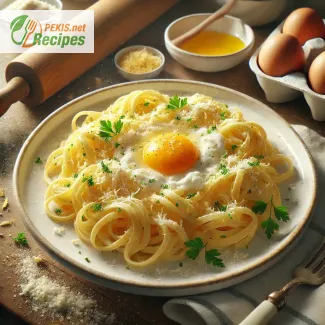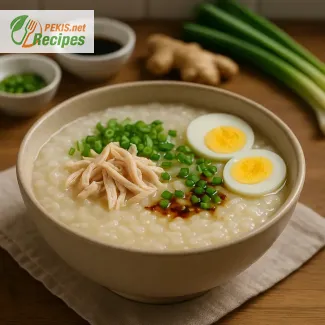
A Timeless Classic: The Perfect Egg and Noodle Dish
A Comforting, Versatile, and Nutritious Meal
Few dishes embody simplicity, comfort, and versatility as well as an egg and noodle recipe. This humble yet satisfying dish has been a staple in various cuisines around the world, from the rich noodle bowls of Asia to the creamy pasta dishes of Europe. Whether served as a quick weekday meal, a hearty breakfast, or a protein-packed post-workout dish, the combination of eggs and noodles offers a perfect balance of flavor and nutrition.
The beauty of this dish lies in its adaptability. With just a handful of ingredients—fresh eggs, quality noodles, and a selection of herbs and seasonings—you can create a delightful meal in minutes. It can be as simple or as elaborate as you like, making it ideal for both busy professionals and home cooks who enjoy experimenting in the kitchen.
The History and Cultural Significance of Egg and Noodles
Throughout history, eggs and noodles have been cherished in numerous cultures. In Chinese cuisine, egg noodles have been enjoyed for centuries, often served in a savory broth or stir-fried with vegetables and meat. In Italian cooking, eggs are the foundation of fresh pasta, providing a rich, silky texture to beloved dishes such as carbonara or fettuccine Alfredo. Meanwhile, in Eastern European traditions, egg noodles are often paired with butter, cheese, or even sweet ingredients for a comforting meal.
This dish not only carries historical significance but also embodies the universal appeal of simple yet flavorful cooking. The pairing of soft noodles with rich, velvety eggs creates a harmonious contrast in texture, making it a timeless favorite among food lovers.
Nutritional Benefits of Egg and Noodle Dishes
One of the greatest advantages of this dish is its nutritional profile. Eggs are an excellent source of high-quality protein, essential for muscle growth and repair. They are packed with vitamins such as B12, D, and A, along with healthy fats that contribute to brain function and overall well-being.
Meanwhile, noodles provide a satisfying source of carbohydrates, essential for sustained energy levels. Depending on the type of noodles used—whether whole wheat, rice, or gluten-free varieties—you can further enhance the dish’s nutritional value. Pairing protein-rich eggs with fiber-packed noodles ensures a balanced meal that keeps you feeling full and energized.
Additionally, by incorporating fresh vegetables, herbs, and lean proteins, you can customize the dish to suit various dietary preferences and nutritional needs. Whether you prefer a low-carb, high-protein version or a vegetarian-friendly adaptation, this recipe can be tailored to fit a range of lifestyles.
Ways to Elevate the Classic Egg and Noodle Recipe
To take your egg and noodle dish to the next level, consider experimenting with different flavors, textures, and ingredients:
Add a Punch of Flavor with Sauces and Seasonings
- Soy sauce and sesame oil for an umami-rich, Asian-inspired dish
- Garlic, butter, and Parmesan for a classic, comforting Italian twist
- Spices like paprika, chili flakes, or turmeric for a bold, aromatic profile
Enhance the Texture with Toppings and Garnishes
- Crispy shallots or fried garlic for a crunchy contrast
- Fresh herbs like cilantro, chives, or basil for a burst of freshness
- Toasted sesame seeds or crushed nuts for added depth
Make It a Complete Meal with Additional Proteins and Vegetables
- Grilled chicken, shrimp, or tofu for extra protein
- Sautéed mushrooms, spinach, or bell peppers to boost vitamins and minerals
- A poached or soft-boiled egg for a silky, decadent touch
The Perfect Meal for Any Occasion
Whether you’re looking for a quick meal after a long day, a hearty weekend brunch, or a satisfying dinner, an egg and noodle dish never disappoints. Its versatility, ease of preparation, and comforting flavors make it a go-to recipe that can be tailored to suit any palate or preference.
By choosing quality ingredients and experimenting with different flavors and textures, you can turn this simple dish into a culinary masterpiece. Whether you enjoy it as a classic street-food-inspired stir-fry, a creamy pasta dish, or a nourishing soup, the combination of eggs and noodles is a testament to the beauty of simple, wholesome cooking.
- Boil the noodles – Bring 250 ml (1 cup) of water to a boil in a large pot. Add the egg noodles and cook according to the package instructions (typically 4–6 minutes). Drain and set aside.
- Prepare the eggs – In a small bowl, whisk the eggs until fully combined. Heat 5 g (1 tsp) of olive oil in a pan over medium heat. Pour in the eggs and scramble gently until just set. Remove from heat and set aside.
- Sauté the garlic – In the same pan, melt 15 g (1 tbsp) of butter. Add the minced garlic and cook for 30 seconds until fragrant.
- Combine ingredients – Add the cooked noodles to the pan and toss to coat with butter and garlic. Pour in the soy sauce, stirring to distribute the flavor evenly.
- Add vegetables and seasoning – Stir in shredded carrots, salt, black pepper, and sesame seeds. Cook for another 2 minutes, allowing the flavors to meld.
- Incorporate the eggs – Return the scrambled eggs to the pan, breaking them into smaller pieces as you mix.
- Garnish and serve – Remove from heat and sprinkle chopped green onions and fresh cilantro on top. Serve immediately.
Elevating the Classic Egg and Noodle Dish
Small Adjustments for a Big Flavor Boost
A traditional egg and noodle dish is already a beloved comfort food, but small enhancements can elevate it from a simple meal to a culinary masterpiece. Whether you prefer a richer, spicier, or more balanced version, making thoughtful ingredient swaps and additions can significantly impact taste, texture, and nutrition.
The Power of Ingredients: How Small Changes Enhance Flavor
Choosing the Right Noodles
While classic egg noodles provide a soft, slightly chewy texture, swapping them for whole wheat, rice, or soba noodles can add a different depth of flavor and nutritional benefits.
- Whole wheat noodles – Rich in fiber and add a slightly nutty taste, making the dish heartier.
- Rice noodles – A gluten-free option with a lighter texture, ideal for those seeking a more delicate bite.
- Soba noodles – Made from buckwheat, they offer an earthy, robust taste and are packed with protein and minerals.
Enhancing the Egg Texture
Eggs are the star ingredient, and how they are prepared greatly impacts the final dish.
- Soft-scrambled eggs create a creamy, silky texture that blends well with the noodles.
- Fried eggs with crispy edges and a runny yolk add a rich, indulgent element.
- Poached eggs introduce a delicate burst of flavor when mixed into the dish.
Adding a touch of cream or milk while whisking the eggs results in a fluffier texture, while butter enhances the richness.
The Role of Seasonings and Aromatics
Balancing Saltiness and Umami
A dish’s depth of flavor relies heavily on the right seasonings.
- Soy sauce adds savory umami and saltiness but can be substituted with tamari (gluten-free) or coconut aminos for a milder version.
- Miso paste brings a fermented, complex richness that enhances every bite.
- Fish sauce contributes a deeper umami note for those who enjoy a more traditional Asian influence.
Introducing Acidity and Sweetness
To balance flavors, a touch of acidity or sweetness brightens the dish.
- A splash of rice vinegar or lime juice enhances freshness and prevents the dish from feeling too heavy.
- A drizzle of honey or brown sugar can counteract excessive saltiness and add subtle complexity.
Avoiding Common Mistakes
Overcooking the Noodles
One of the biggest mistakes is overcooking noodles, leading to a mushy texture. To prevent this:
- Cook noodles 1 minute less than package instructions and finish cooking in the sauce.
- Rinse with cold water to stop the cooking process if not using immediately.
Overcrowding the Pan
Cooking too many ingredients at once can lower the pan’s temperature, resulting in steamed instead of sautéed ingredients.
- Cook in batches to maintain optimal heat and caramelization.
Using Low-Quality Ingredients
- Fresh eggs provide brighter yolks and superior taste compared to mass-produced ones.
- High-quality soy sauce and oils ensure a more refined, authentic flavor.
Making It Healthier Without Sacrificing Taste
Opting for Healthier Oils
Instead of regular vegetable oil, use:
- Avocado oil – Rich in healthy fats and has a high smoke point.
- Sesame oil (used sparingly) – Adds an authentic, toasty depth.
Increasing Nutritional Value
Adding more vegetables and protein sources can transform the dish into a nutrient-dense meal:
- Spinach, kale, or bok choy for an iron and vitamin boost.
- Mushrooms to add a savory, umami flavor.
- Lean chicken, shrimp, or tofu for extra protein and texture variety.
Why Homemade Is Better Than Takeout
Control Over Ingredients
Homemade versions avoid excessive sodium, MSG, and preservatives found in takeout meals.
Customization for Dietary Needs
Adjusting ingredients makes it easy to create:
- Low-carb versions by using zucchini noodles.
- Vegan options by replacing eggs with scrambled tofu.
Cost-Effective and Fresh
Cooking at home ensures fresher ingredients and is more budget-friendly than frequent takeout orders.
By making thoughtful improvements, a simple egg and noodle dish can become a gourmet experience tailored to personal taste and dietary needs. With the right ingredients, cooking techniques, and seasoning adjustments, this classic dish can be elevated into a well-balanced, satisfying meal.
Contains eggs, gluten (from noodles and soy sauce), and sesame.
Gluten-Free Substitutions: Use gluten-free rice noodles and tamari instead of soy sauce. SOURCE: official source on gluten-free diets
- Vitamin A: 1200 IU (supports vision and immune health) SOURCE: USDA FoodData Central
- Vitamin B12: 1.2 µg (crucial for red blood cell formation) SOURCE: NIH Office of Dietary Supplements
- Iron: 2 mg (supports oxygen transport in blood) SOURCE: CDC Nutrition
- Calcium: 50 mg (important for bone strength) SOURCE: NIH Bone Health
- Vitamin C: 6 mg (boosts immune function and skin health) SOURCE: USDA FoodData Central
- Beta-carotene: 450 µg (protects cells from oxidative stress) SOURCE: NIH Antioxidants
- Selenium: 15 µg (supports thyroid function and reduces inflammation) SOURCE: NIH Office of Dietary Supplements





